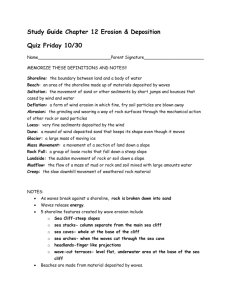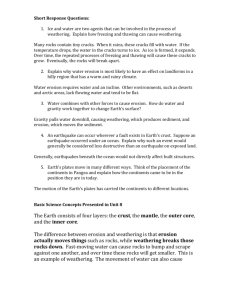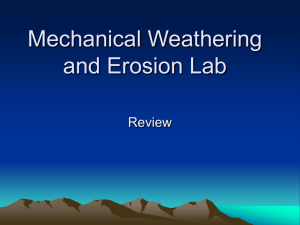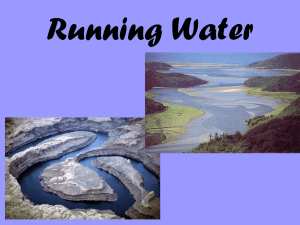GEOLOGICAL WORK OF WIND Atmosphere is composed mainly of
advertisement
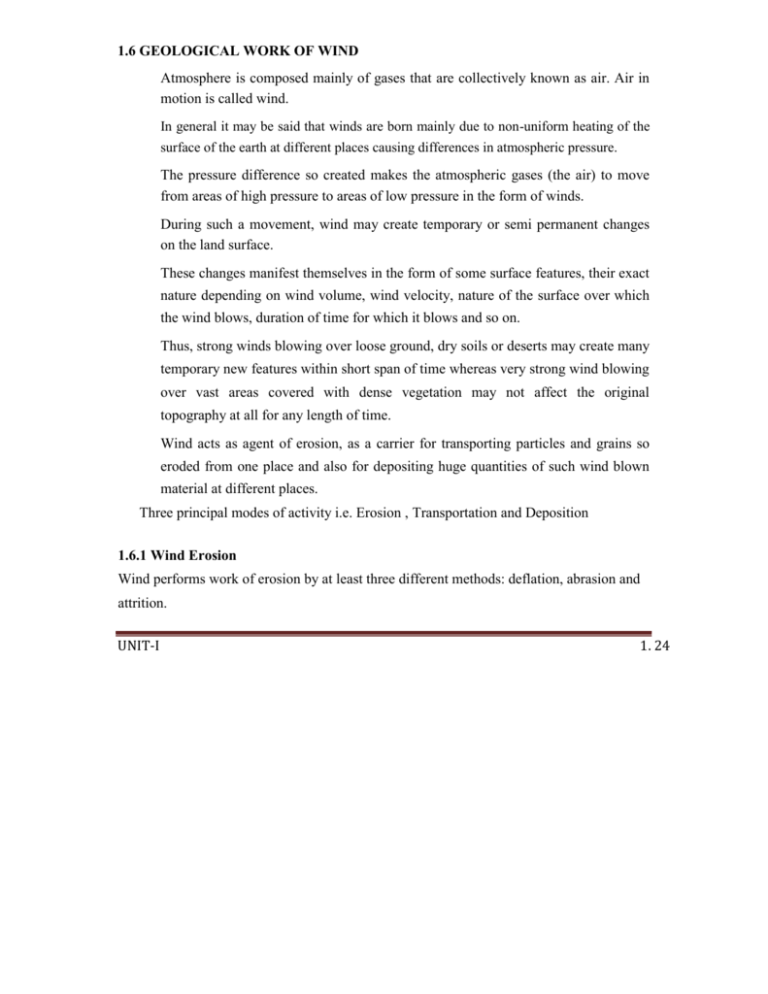
1.6 GEOLOGICAL WORK OF WIND Atmosphere is composed mainly of gases that are collectively known as air. Air in motion is called wind. In general it may be said that winds are born mainly due to non-uniform heating of the surface of the earth at different places causing differences in atmospheric pressure. The pressure difference so created makes the atmospheric gases (the air) to move from areas of high pressure to areas of low pressure in the form of winds. During such a movement, wind may create temporary or semi permanent changes on the land surface. These changes manifest themselves in the form of some surface features, their exact nature depending on wind volume, wind velocity, nature of the surface over which the wind blows, duration of time for which it blows and so on. Thus, strong winds blowing over loose ground, dry soils or deserts may create many temporary new features within short span of time whereas very strong wind blowing over vast areas covered with dense vegetation may not affect the original topography at all for any length of time. Wind acts as agent of erosion, as a carrier for transporting particles and grains so eroded from one place and also for depositing huge quantities of such wind blown material at different places. Three principal modes of activity i.e. Erosion , Transportation and Deposition 1.6.1 Wind Erosion Wind performs work of erosion by at least three different methods: deflation, abrasion and attrition. UNIT-I 1. 24 (a) Deflation By itself, wind possesses not much erosive power over rocks or over the ground covered with vegetation. But when moving with sufficient velocity over dry and loose sands or bare ground over dust, it can remove or sweep away huge quantity of the loose material from the surface. This process of removal of particles of dust and sand by strong winds is called deflation. It is the main process of wind erosion in desert regions. In fact, in some deserts, deflation may cause the removal of sand from a particular location to such an extent that a big enough depression is created, sometimes with its base touching the water table at quite a depth. Such depressions are variously called blowouts when developed on a small scale and of shallower depth. Much deeper and extensive depression where the water table is intersected and it gets partially filled up with water is called an OASIS. Oases are the most sought after locations in deserts for more than one reason: it is only around them that some vegetation may grow and also they sustain temporary or semi permanent shelters. Fig: 1.9 Oasis UNIT-I 1. 25 Slack is another term used for such depressions created by deflation. The Quattara depression of western Egypt is one of the biggest slacks. It is 300 km long and 150 km wide; its base is 130 m below sea level. Another feature produced due to deflation is called a Hamada. It is a bare rock surface in a desert from over which thin cover of sand has been blown away by strong winds. It is also called a desert pavement and may extend for considerable distance in a desert region. (b) Wind Abrasion Wind becomes a powerful agent for rubbing and abrading the rock surfaces when naturally loaded with sand and dust particles. This load is acquired by the strong winds quite easily when blowing over sand dunes in deserts and over the dry ploughed fields. This type of erosion involving rubbing, grinding, abrading and polishing the rock surfaces by any natural agent (wind, water or ice) with the help of its load while passing over the rocks is termed as abrasion. Yardangs. These are elongated, low-lying ridges forming overhangs above local depressions. Yardangs are formed in areas where rocks of alternate hard and soft character are laying one above another with a general gentle slope. Fig: 1.10 Yardangs UNIT-I 1. 26 Pedestal rocks These are pillar like rock masses with narrow base and wide rock caps Pinnacles are similar features with less prominent cap rock. These are produced by combined action of weathering, gravity and wind abrasion. However, it is the wind abrasion which is Pedestal rock mainly responsible for the formation of this pillar - like structures. Fig: 1.11 Pedestal rock Ventifacts: These are small sized rock fragments showing one, two or three or even more typically win polished surfaces called faces. Polished and faceted rock fragments are called Ventifacts. Wind blowing in a particular direction, produce smooth and flat surfaces. Fig: 1.12 Ventifacts Desert pavement: In deserts and semi-deserts, the dust and finer particles of the weathered rocks are blown out by the wind, and heavier pebbles and rock fragments are left out. After long exposure to UNIT-I 1. 27 wind, the fragments and pebbles become finely polished. This type of land surface is termed as desert pavement which is like a sea broken rocks. They are lag deposits. The areas with large sized rock fragments are termed as hammadas. Fig: 1.13 Desert pavement Attrition by wind: The wind-borne particles, traveling in suspension do often have the chance of colliding with one another. Such mutual collision amongst themselves causes a further grinding of the particles and the process is described as attrition.The three processes of erosion, namely deflation, abrasion and attrition generally operate simultaneously under favorable conditions and causes appreciable degradation of the landmass on which they work. 1.6.2 Wind Transportation Observations made in the deserts and also in the laboratory show that loose particles are transported by wind in three ways [1] suspended load [2] saltation load [3] traction load. 1. The suspended load consists mainly of dust or clay sized particles, which are in continuous suspension due to the turbulence of the wind. 2. Most sand grains move forward in a series of leaps and jumps, commonly referred to as saltation. The sand grains bounce up into the air under the impact of another particle. 3. Some sand grains particularly the larger ones are unable to raise into the air due to their size even under the impact of other grains. They simply roll forward along the ground and this movement is called traction. Wind Deposition: Whenever wind looses its velocity, the wind-borne particles are dropped back to the ground where they may accumulate to form wind deposits. Any obstacle in the path of the wind like boulders, hills, buildings etc. diverts the wind and causes the load to dropped UNIT-I 1. 28 resulting in the accumulation of the deposits. The two main types of depositional features formed by the wind are 1] sand dunes and 2] loess. 1. Sand Dunes Wind formed deposits of sand are commonly described as DUNES. It is mound or a ridge of windblown sand that rises to a definite summit or crest. It shows a profile having a gentle windward slope and a steep leeward slope. Many dunes grow to heights of 30m to 100m. As the wind blows over the sand dune, the sand grains roll along the wind ward slope towards the crest of the dune and they fall over onto the leeward slope. The lee side thus, assumes an angle of repose for the sand grain, which is about 30˚ to 34˚. Thus, migration of a dune takes place by the transfer of sand from the windward side to the dune crest where the sand rolls or slides down the slip face onto the leeward side. As the sand accumulation continues with periodic sliding of the sand grains along the slip face, the dune slowly migrates in the direction of the wind. A dune may travel as much as 20m on an extremely windy day. Sand dunes are described according to their shape or form as i. Barchan dune ii. Transverse dune iii. Parabolic dunes iv. Longitudinal dunes. Barchan dunes: A barchan dune is an isolated crescent shaped dune. It forms mainly because the velocity wind is largely resisted at the central part of the dune and more along the flanks. Thus, the flanks point inwards like two points or ‘horns’ with a concave leeward slope or the slip face. The wind energy transfers the sand from the windward side towards the slip face, where it slides down at a rate of several centimeters to about 15m/year. Barchans may grow to a height of 30m with a width of 400m. e.g. north African and Arabian deserts. Fig: 1.14 Barchan dunes UNIT-I 1. 29 Transverse dune: are typically developed along the seacoast where there is a large supply of sand and a constant wind direction. The wind driven sand accumulates nearly parallel to the coastline or gets oriented across the direction of the flow of the wind and hence called transverse dunes. In majority of the cases the sand gets transported from the windward side towards the leeward side by virtue of which the dune migrates or advances inland which is a nuisance to the adjoining areas. However, these can be stabilized by growing creepers or shrubs on the dunes. Fig: 1.15 Transverse dune Parabolic dunes: are most commonly observed in the coastal areas. These are convex shaped in the leeward direction. In other words they are more or less like reversed barchans. i.e. their horns point towards the windward direction. The sparse vegetation cover permits limited migration of the sand along such dunes. Fig: 1.16 Parabolic dunes Longitudinal dunes: are developed in very dry regions where sand supply is scanty but the wind is strong. Under such conditions these dunes occur in the form of long ridges of UNIT-I 1. 30 sand, which are parallel to the general wind direction. These dunes vary in height from less than 8meters to around 100m and their lengths range from 60m to several kilometers. E.g. longitudinal dunes of Libyan Desert. 2. Loess As strong wind starts blowing over the desert, a large quantity of dust particles [<0.01 mm] are taken in suspension and are carried for long distances. Ultimately these particles settle down to form thick, fertile, blanket-like deposits called loess. Example Deserts of China and Asia. The constituting material is yellowish or light buff colored, very fine grained and in most cases devoid of vegetation. This is because the grain size is too small to produce layering and the plants, worms and other organisms churn up the sediments as they are deposited. These are known for their high potassium content and exceptionally thick deposits of about 60meters are observed in China. 1.7 GEOLOGICAL WORK OF STREAMS AND RIVERS 1.7.1 METHODS OF RIVER EROSION By erosion is meant disintegration and decomposition of the rocks and soil material by a natural agent through mechanical, chemical and other physico-chemical processes accompanied by removal of the disintegrated or decomposed product to far off places by the same agent. (a) Hydraulic Action It is the mechanical loosening and removal of the material from the rocks due to pressure exerted by the running water. The higher- the velocity, the greater is the pressure of the running water and hence greater is its capacity to bodily move out parts of the rock or grains of soil from the parent body occurring along its base or sides. Occurrence of planes of weakness in the rocks such as joints, fissures, cavities and cracks are especially helpful to the running water in carrying out hydraulic action. The river water flowing with sufficient velocity often develops force strong enough to disintegrate a loose rock, displace the fragments so created and lift them up and move forward as part of bed load. At places, where some of the out from the bedrock the river bed may develop potholes. UNIT-I 1. 31 (b) Cavitations It is a distinct and rare type of hydraulic action performed by running water. It is particularly observed where river water suddenly acquires exceptionally high velocity such as at the location of a waterfall. It is known that where stream velocity exceeds 12m/sec, the water pressure developed at the impinging points equals vapour pressure. (c) Abrasion It is the principal method of stream erosion and involves wearing away of the bedrocks and rocks along the banks of a stream or river by the running water with the help of sand grains, pebbles and gravels and all such particles that are being carried by it as load. These particles, grains and rock fragments moving along with river water are collectively known as tools of erosion. Abrasion is, in fact, a sort of impact and scour method involving loosening, disintegrating, rubbing, grinding and polishing action of tools on the rocks of the channel. (d) Attrition Term is used for wear and tear of the load sediments being transported by a moving natural agency through the process of mutual impacts and collusions which they suffer during their transport. Every part of the sediment in load in suspension or being moved along the bed of the stream receives repeated impacts from other particles. Due to these mutual collusions, the irregularities and angularities of the particles are worn out. These become spherical in outline and rounded and polished at the surface. (e) Corrosion The slow but steady chemical (especially solvent) action of the stream water on the rocks is expressed by the term corrosion. The extent of corrosion depends much on the composition of rocks and also on the composition of flowing water. Limestones, gypsum and rock salt bodies are soluble in water to varying degrees. The stream may hardly corrode sandstones, quartzites, granites and gneisses. UNIT-I 1. 32 1.7.2 FEATURES OF STREAM EROSION 1. Potholes These are variously shaped depressions of different dimensions that are developed in the riverbed by excessive localized erosion by the streams. The potholes are generally cylindrical or bowl shaped in outline and range from a few centimeters to many meters in diameter as well as in depth. The formation process for a pothole may be initiated by a simple plucking out of a protruding or outstanding rock projection at the riverbed by hydraulic action. This produces a small depression only at the place of plucking in the otherwise normal bedrock. Some of the depressions so initiated may eventually become the spots where pebbles and gravels of the stronger rocks are caught in eddies and thrown into a swirling or churning motion. Fig: 1.17 Potholes 2. River Valleys A valley may be defined as a low land surrounded on sides by inclined hill slopes and mountains. Every major river is associated with a valley of its own. In fact, rivers are responsible for the origin, development and modification of their valleys through well- understood processes of river erosion. For instance, origin and deepening, lengthening and widening of river valleys are often explained as follows. (a) Origin. A river valley may have a modest origin when traced backwards in the geological history of the area. UNIT-I 1. 33 . On a gently sloping land surface, rain-water gets collected along lower level and flows as small streamlets or rivulets. In a short time, small gullies are produced where rainwater gets naturally collected from the adjoining slopes. The gullies are, therefore, incipient valleys Further erosion deepens and widens an original gully that can accommodate bigger volumes of water and thus suffer greater erosion. In this way a small-scale gully may, with the passage of geological time, eventually grow into a large- scale feature of the same character and may be called a valley. (b) Valley deepening. It is achieved by cooperative action of all the processes involved in erosion: hydraulic action, abrasion and chemical action or corrosion. Deepening is obviously caused due to cutting down of the riverbed, which depends to a great extent on the velocity of stream and all the factors controlling the velocity. (c) Lengthening of River Valley. A peculiar type of is generally held responsible for lengthening of river valleys. In this process, the streams or rivers are more actively eroding in the higher up regions, close to their points of origin. Here each stream or river receives a number of tributaries having their origin in the areas away from the point of origin of the main stream. River Capture (Piracy) A peculiar phenomenon of capture of drainage basin of one river by another river fast eroding its channel in headward direction has been seen at many places. In this case the divide between the two rivers say A and B gets eroded at a certain point to such an extent that finally part or whole of water of river B gets diverted to river A through a gap created at the divide by the river A. The process of river piracy is of considerable significance in the drainage basins of both the rivers in their geological work after the capture. UNIT-I 1. 34 Fig: 1.18 Valley Lengthening (d) Streams achieve valley widening The streams cut down their channels and also remove away the loose soil and rocks from the banks thereby widening the valley directly. This process cannot be expected to have widened their valleys to many times the width of the stream. As is known, once a small valley is created, the slopes of the valley are always exposed to the secondary processes such as weathering of all types, rain-wash, soil creep and landslides etc. The combined action of these secondary processes loosens the material from the slopes. This material is passed on to the river flowing down at the base of the valley that carries it away sooner or later. Thus, rivers contribute to valley widening by actively transporting whatever material is supplied to them from the valley slopes produced there through the processes of mass wasting. Gorges and Canyons The process of valley deepening often gives rise to magnificent surface features known as gorges and canyons. Gorges are very deep and narrow valleys with very steep and high walls on either side. Their length varies considerably, from a few meters to several kilometers at a stretch. A canyon is a specific type of gorge where the layers cut down by a river are essentially stratified and horizontal in attitude. UNIT-I 1. 35 Valley Profile Rivers exhibit certain peculiarities about development of their valleys that are best understood with respect to their transverse and longitudinal profiles. Transverse Profile. In the mountainous and hilly tracts where a stream flows with very high velocity and where flow is often of turbulent character, the valley cross-sections at different places closely resemble to a V-shape. This may be attributed to down cutting of the river bed at a much faster rate compared to widening of the valley that is achieved mostly by secondary processes of mass wasting which operate comparatively at a slow rate. Theoretically this deepening process could continue till the base level of that river is achieved. Practically, however, most streams become sluggish much earlier due to reduction in slope channel. The V-shape of the river valley developed in the initial stages is subject to modification with the passage of time, especially on account of operation of valley widening processes. A mature river valley, therefore, may show good departure from the original Vshape. It may have a much wider base with very gentle slopes. Even this mature shape of the river valley may ultimately get worn-out after ages of geological work in the area to almost flat-banks in the old age of the river. Fig: 1.19 Transverse Profile. Longitudinal Profile It may be defined as a curve depicting the course of a stream from its head (place of origin) to its mouth (place of emptying into lake or sea). UNIT-I 1. 36 For a major river originating from back in the mountains and emptying into a sea, the longitudinal profile is a curve with a steep slope in the hills that gets reduced gradually to flattening lines for the plain region. For every stream, the main tendency is to achieve a straight longitudinal profile, as near as possible, to the base level of erosion. (e) Escarpments These are erosional features produced by rivers in regions composed of alternating beds of hard and soft rocks. The river easily and quickly erodes the soft layers whereas the hard layers resist the erosion and stand projecting as ledges on the sides. These ledges are gradually undercut by continued stream erosion. A time comes when a given ledge is no longer able to support itself any further and hence falls down in the river giving rise to a steep slope in its place. It is this steep slope caused by falling of undercut ledge of hard rocks that is referred to as an Escarpment. Dip Slope In some cases a stream may succeed in completely eroding the overlying softer rock, thereby fully exposing the underlying hard layer all along its dip (i.e. the angle of inclination of the layer with the horizontal). The resulting slope is the same as the dip of the layer and becomes in itself a typical erosional feature. It is called a dip slope. Fig: 1.20 Escarpments and related features CUESTA It is the term given to a combined set of escarpment and dip slope occurring adjacently in an area of escarpment topography. UNIT-I 1. 37 Obviously it results due to prolonged erosion of rocks forming the channel of a river and having been made of alternating hard and soft layers of rocks. Fig: 1.21 Developments of Escarpments and Dipslope Hogback It is an erosional feature made by streams and is carved out from very steeply inclined rocks that have proved resistant to erosion. The hogback is a typically outstanding outcrop of hard rock having erosional slopes on either side. Mesa and Butte These are erosional features made up essentially of horizontally layered rocks, having a cap of hard and resistant rocks that have escaped erosion. Large sized caps are called mesa whereas comparatively small sized and isolated patches are called butte or kopjees. These features (Mesa and Butte) result in areas of alternating hard and soft layers exposed to river erosion. Fig: 1.22 Mesa and Butte UNIT-I 1. 38 Waterfalls These are defined as magnificent jumps made by stream or river water at certain specific parts of their course where there is a sudden and considerable drop in the gradient of the channel. In a waterfall, the stream literally falls (instead of flowing) from a considerable height before acquiring normal flow again at a lower level. Obviously, the velocity of water at the point of fall increases tremendously. Successive falls of smaller heights are sometimes referred as rapids and cascades. Many falls are easily attributed to unequal erosion of the channel rocks within a short distance due to the inherent nature of the rocks. Thus, as and where the river channel is made up of a width of rock of softer character intervening a rock of sound and strong character, the weaker rock will be eroded much faster, creating a depression just ahead of the resistant ledge. The water falling from the ledge gains in velocity thereby increasing the erosion of the softer bed below to still higher rates. Stream Terraces These are bench like ledges or flat surfaces that occur on the sides of many river valleys. From a distance, they may appear as succession of several steps of a big natural staircase rising up from the riverbank. They may be made up of hard rock or of soft rock, but the essential thing is that they look like steps. Some of them are clearly features of river erosion indicating that the stream has cut down its own channel not continuously but in a series of stages. Fig: 1.23 River Terraces UNIT-I 1. 39

